PONTIAC GRAND AM 2003 Owners Manual
Manufacturer: PONTIAC, Model Year: 2003, Model line: GRAND AM, Model: PONTIAC GRAND AM 2003Pages: 354, PDF Size: 16.3 MB
Page 91 of 354
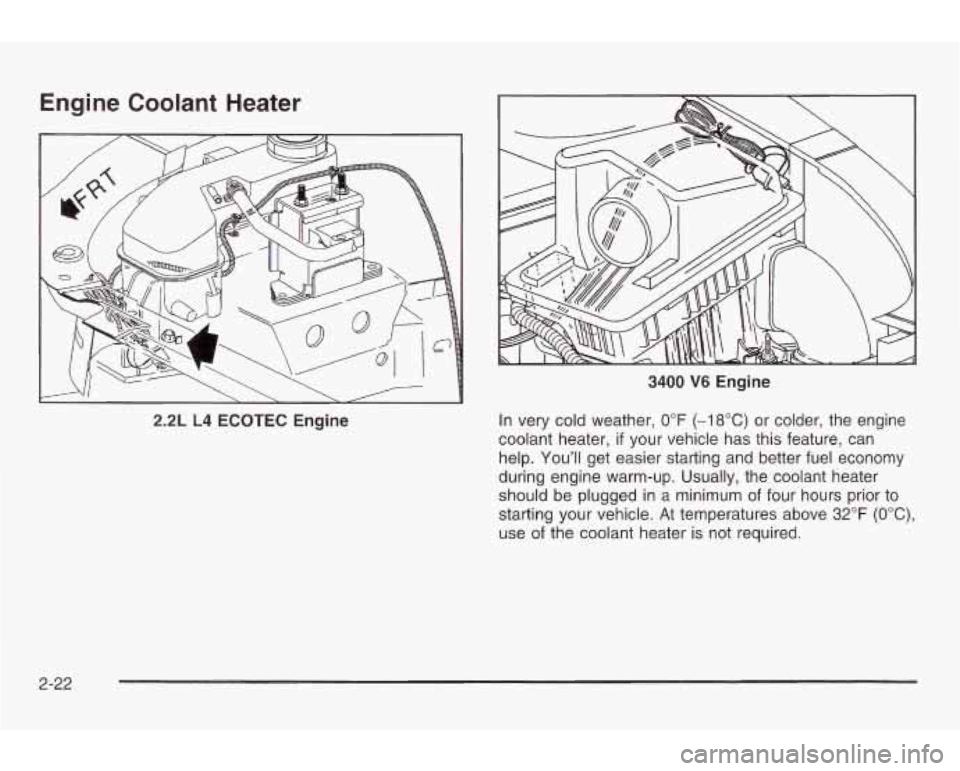
Engine Coolant Heater
3400 V6 Engine
2.2L L4 ECOTEC Engine In very cold weather, 0°F (-18°C) or colder, the engine
coolant heater,
if your vehicle has this feature, can
help.
You'll get easier starting and better fuel economy
during engine warm-up. Usually, the coolant heater
should be plugged in a minimum of four hours prior to
starting your vehicle. At temperatures above
32°F (OOC),
use of the coolant heater is not required.
2-22
Page 92 of 354
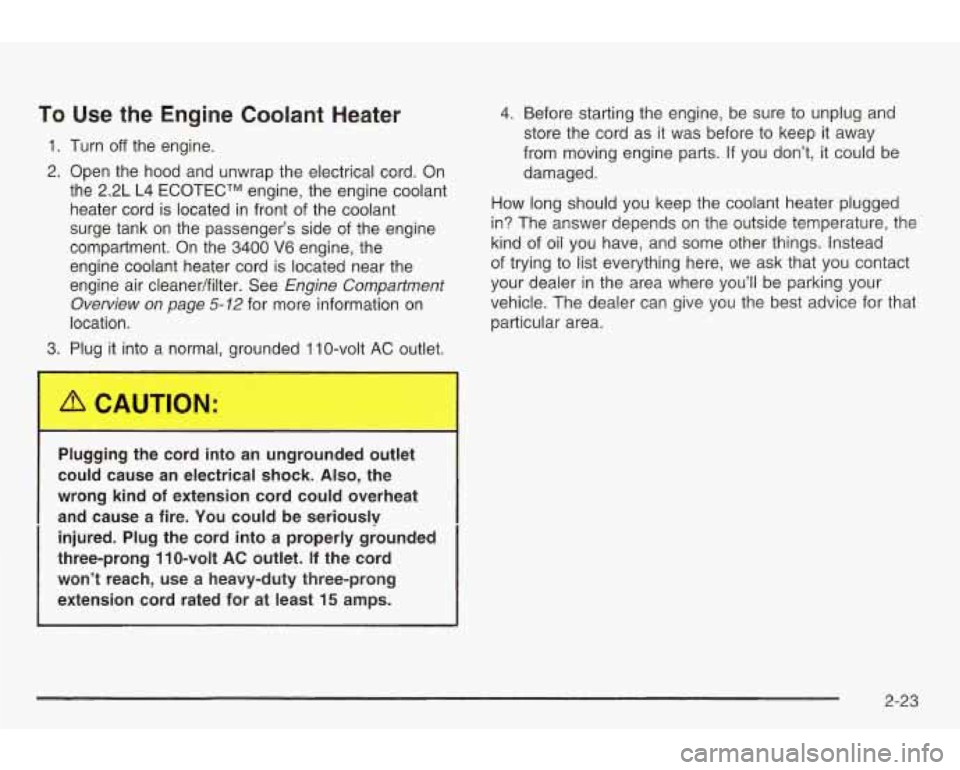
To Use the Engine Coolant Heater
1. Turn off the engine.
2. Open the hood and unwrap the electrical cord. On
the 2.2L L4 ECOTECTM engine, the engine coolant
heater cord is located in front of the coolant
surge tank on the passenger’s side of the engine
compartment. On the 3400
V6 engine, the
engine coolant heater cord is located near the
engine air cleaner/filter. See
Engine Compartment
Overview
on page 5-12 for more information on
location.
3. Plug it into a normal, grounded 1 IO-volt AC outlet.
4. Before starting the engine, be sure to unplug and
store the cord as
it was before to keep it away
from moving engine parts. If you don’t, it could be
damaged.
How long should
you keep the coolant heater plugged
in? The answer depends on the outside temperature, the
kind of
oil you have, and some other things. Instead
of trying to list everything here, we ask that you contact
your dealer in the area where you’ll be parking your
vehicle. The dealer can give
you the best advice for that
particular area.
Plugging the cord into an ungrounded outlet
could cause an electrical shock. Also, the
wrong kind of extension cord could overheat
and cause a fire. You could be seriouslv
injured. Plug the cord into a properly grounded
three-prong
1 IO-volt AC outlet. If the cord
won’t reach, use a heavy-duty three-prong
extension cord rated for at least
15 amps.
2-23
Page 93 of 354
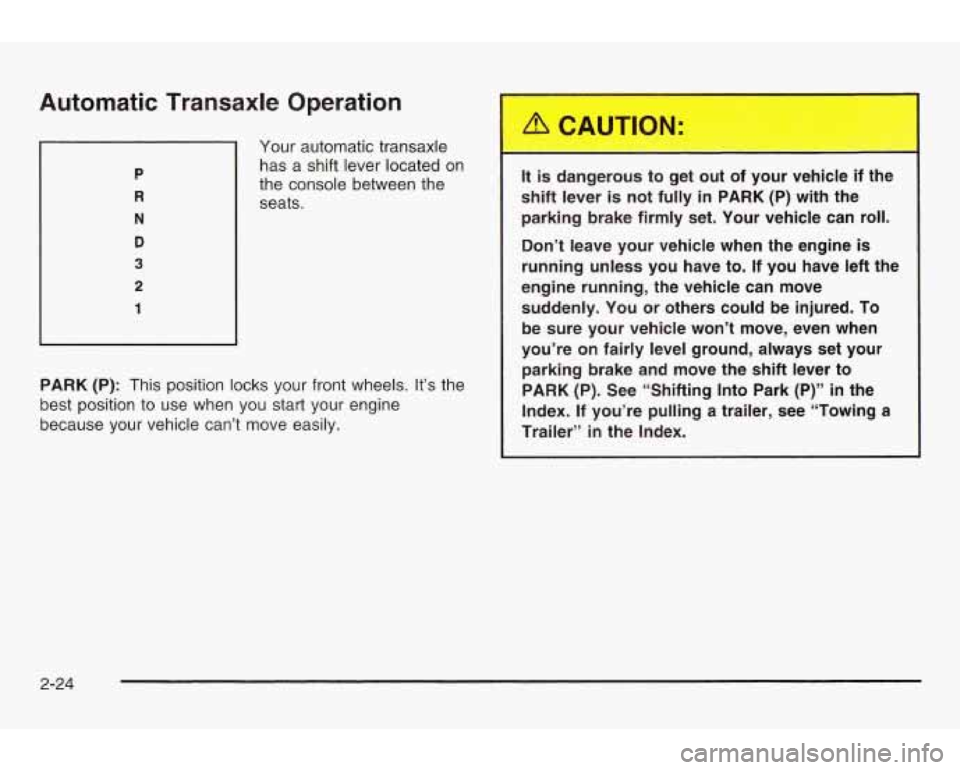
Automatic Transaxle Operation
2
1
I
Your automatic transaxle has a shift lever located on
the console between the
seats.
PARK (P): This position locks your front wheels. It’s the
best position
to use when you start your engine
because your vehicle can’t move easily.
It is dangerous to get out of your vehicle if the
shift lever
is not fully in PARK (P) with the
parking brake firmly set. Your vehicle can roll.
Don’t leave your vehicle when the engine is
running unless you have to. If you have left the
engine running, the vehicle can move suddenly. You or others could
be injured. To
be sure your vehicle won’t move, even when
you’re on fairly level ground, always set your parking brake and move the shift lever to PARK
(P). See “Shifting Into Park (P)” in the
Index. If you’re pulling a trailer, see “Towing a
Traileryy
in the Index.
2-24
Page 94 of 354
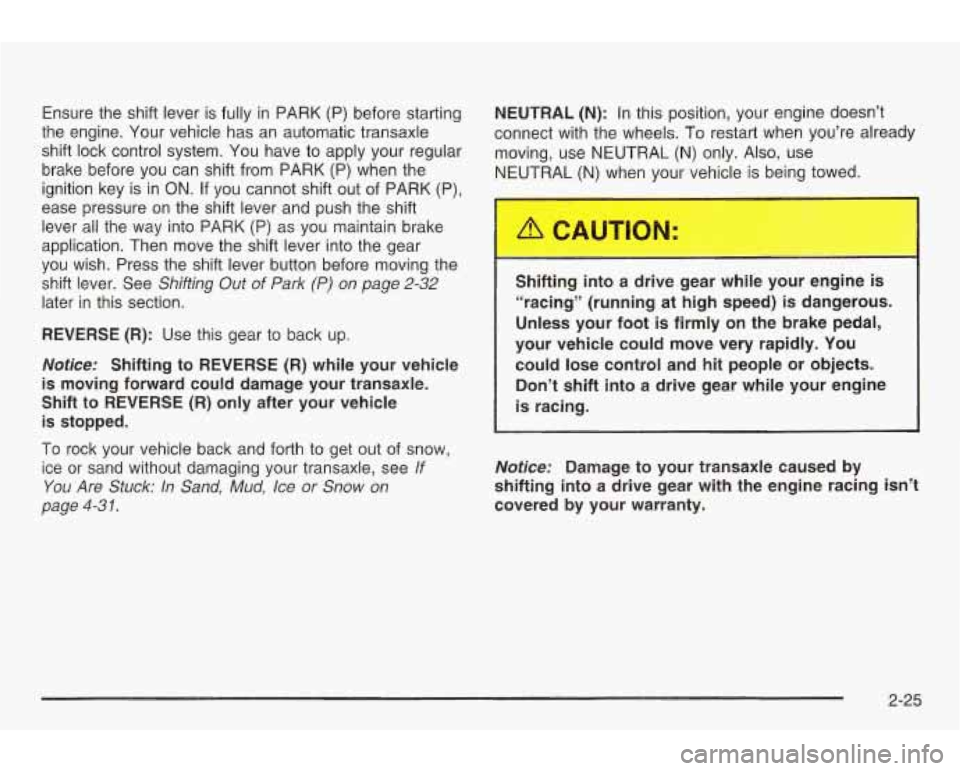
Ensure the shift lever is fully in PARK (P) before starting
the engine. Your vehicle has an automatic transaxle
shift lock control system. You have to apply your regular
brake before you can shift from PARK (P) when the
ignition key is in
ON. If you cannot shift out of PARK (P),
ease pressure on the shift lever and push the shift
lever all the way into PARK (P) as you maintain brake
application. Then move the shift lever into the gear
you wish. Press the shift lever button before moving the
shift lever. See
Shifting Out of Park (P) on page 2-32
later in this section.
REVERSE (R): Use this gear
to back up.
Notice: Shifting to REVERSE (R) while your vehicle
is moving forward could damage your transaxle.
Shift to REVERSE (R) only after your vehicle
is stopped.
To rock your vehicle back and forth to get out of snow,
ice or sand without damaging your transaxle, see
If
You Are Stuck: In Sand, Mud, Ice or Snow on
page 4-3 1.
NEUTRAL (N): In this position, your engine doesn’t
connect with the wheels.
To restart when you’re already
moving, use NEUTRAL (N) only. Also, use
NEUTRAL (N) when your vehicle is being towed.
Shifting into
a drive gear while your engine is
“racing” (running at high speed) is dangerous. Unless your foot is firmly on the brake pedal,
your vehicle could move very rapidly. You could lose control and
hit people or objects.
Don’t shift into a drive gear while your engine
is racing.
~~
Notice: Damage to your transaxle caused by
shifting into a drive gear with the engine racing
isn’t
covered by your warranty.
2-25
Page 95 of 354

AUTOMATIC OVERDRIVE (D): This position is for
normal driving.
If you need more power for passing, and
you’re:
Going less than 35 mph (55 km/h), push your
Going about 35 mph (55 km/h) or more, push the
You’ll shift down to the next gear and have more power.
accelerator pedal about halfway
down.
accelerator all the way down.
Notice: If your vehicle seems to start up rather
slowly, or if
it seems not to shift gears as you go
faster, something may be wrong with a transaxle system sensor.
If you drive very far that way, your
vehicle can be damaged.
So, if this happens,
have your vehicle serviced right away. Until then,
you can use SECOND
(2) when you are driving less
than
35 mph (55 km/h) and AUTOMATIC
OVERDRIVE (D) for higher speeds. THIRD
(3): This position is also used
for normal driving.
However, it offers more power and lower fuel economy
than AUTOMATIC OVERDRIVE (D). Here are some
times you might choose THIRD
(3) instead of
AUTOMATIC OVERDRIVE (D):
When driving on hilly, winding roads.
0 When towing a trailer, so there is less shifting
between gears.
When going down a steep hill.
SECOND
(2): This position gives you more power but
lower fuel economy. You can use SECOND
(2) on
hills. It can help control your speed as you go down
steep mountain roads, but then you would also want to
use your brakes
off and on.
Notice: Don’t drive in SECOND (2) for more than
25 miles (40 km), or at speeds over 55 mph
(90 km/h), or you can damage your transaxle. Use
THIRD
(3) or AUTOMATIC OVERDRIVE (D) as
much as possible. Don’t shift into SECOND (2)
unless you are going slower than 65 mph (105 km/h)
or you can damage your engine.
2-26
Page 96 of 354
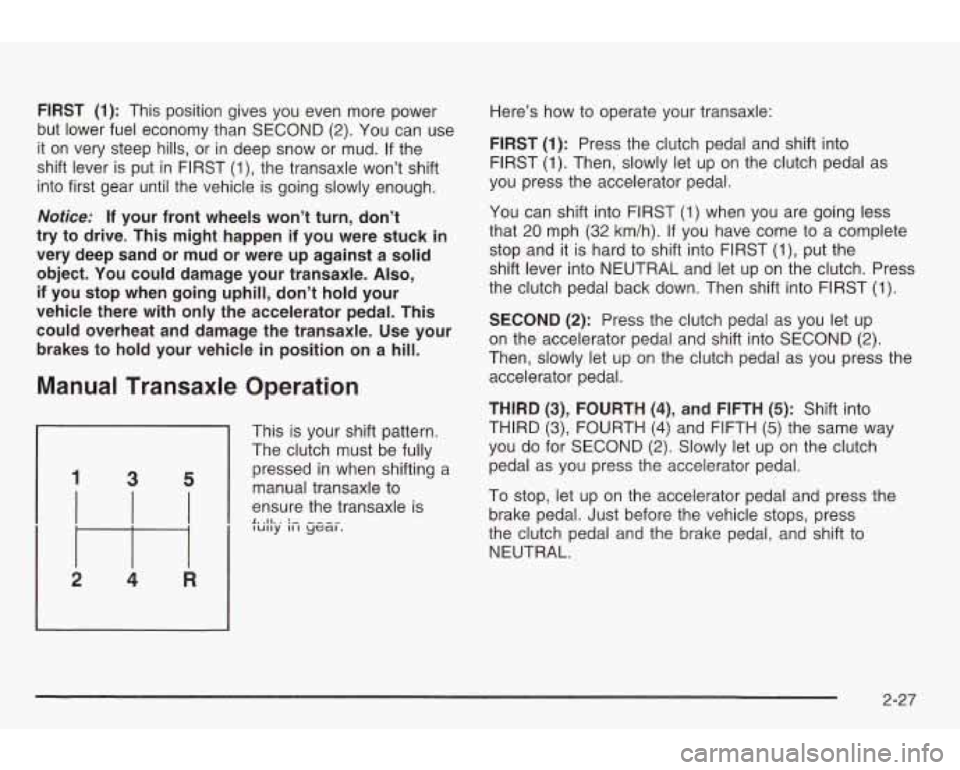
FIRST (1): This position gives you even more power
but lower fuel economy than SECOND
(2). You can use
it on very steep hills, or in deep snow or mud.
If the
shift lever is put in FIRST
(I), the transaxle won’t shift
into first gear until the vehicle
is going slowly enough.
Notice: If your front wheels won’t turn, don’t
try to drive. This might happen
id you were stuck in
very deep sand or mud or were up against a solid
object. You could damage your transaxle.
Also,
if you stop when going uphill, don’t hold your
vehicle there with only the accelerator pedal. This
could overheat and damage the transaxle. Use your
brakes to hold your vehicle in position on a hill.
Manual Transaxle Operation
Here’s how to operate your transaxle:
FIRST
(1): Press the clutch pedal and shift into
FIRST
(1). Then, slowly let up on the clutch pedal as
you press the accelerator pedal.
You can shift into FIRST
(1) when you are going less
that
20 mph (32 km/h). If you have come to a complete
stop and it
is hard to shift into FIRST (I), put the
shift lever into NEUTRAL and let up on the clutch. Press
the clutch pedal back down. Then shift into FIRST
(1).
SECOND (2): Press the clutch pedal as you let up
on the accelerator pedal and shift into SECOND
(2).
Then, slowly let up on the clutch pedal as you press the
accelerator pedal.
1 3 5
THIRD (3), FOURTH (4), and FIFTH (5): Shift into
This
is your shift pattern. THIRD (3), FOURTH (4) and FIFTH (5) the same way
The clutch must be fully you do for SECOND
(2). Slowly let up on the clutch
manual transaxle
to
ensure the transaxle is
pressed
in when shifting a pedal as
YOU press the accelerator pedal.
To stop, let up on the accelerator pedal and press the
the clutch pedal and the brake pedal, and shift to
NEUTRAL.
L. .II. I :- -^^“ brake pedal. Just before the vehicle stops, press lully Ill ycal.
2-27
Page 97 of 354
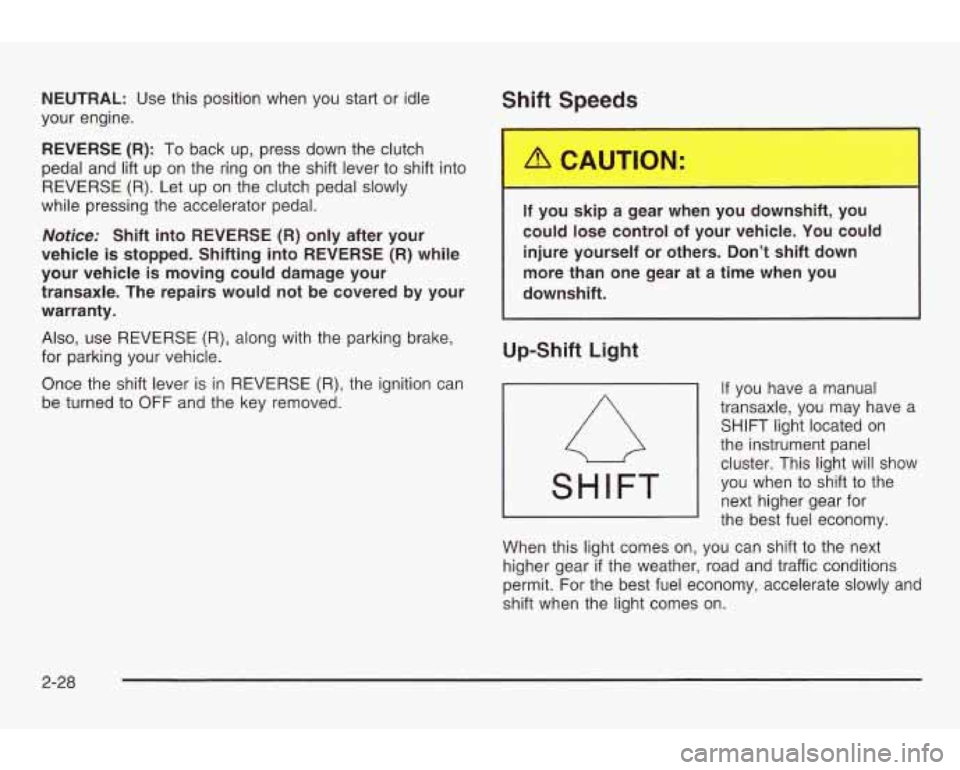
NEUTRAL: Use this position when you start or idle
your engine.
REVERSE (R): To back up, press down the clutch
pedal and
lift up on the ring on the shift lever to shift into
REVERSE
(R). Let up on the clutch pedal slowly
while pressing the accelerator pedal.
Notice: Shift into REVERSE (R) only after your
vehicle
is stopped. Shifting into REVERSE (R) while
your vehicle is moving could damage your
transaxle. The repairs would not be covered by your
warranty.
Also, use REVERSE (R), along with the parking brake,
for parking your vehicle.
Once the shift lever is in REVERSE (R), the ignition can
be turned to OFF and the key removed.
S ft Speec'
If you skip a gear when you downshift, you
could lose control
of your vehicle. You could
injure yourself or others. Don't shift down
more than one gear
at a time when you
downshift.
Up-Shift Light
If you have a manual
transaxle, you may have a
SHIFT light located on
the instrument panel
cluster. This light will show
you when to shift to the
next higher gear for
the best fuel economy.
When this light comes
on, you can shift to the next
higher gear
if the weather, road and traffic conditions
permit. For the best fuel economy, accelerate slowly and
shift when the light comes on.
2-28
Page 98 of 354
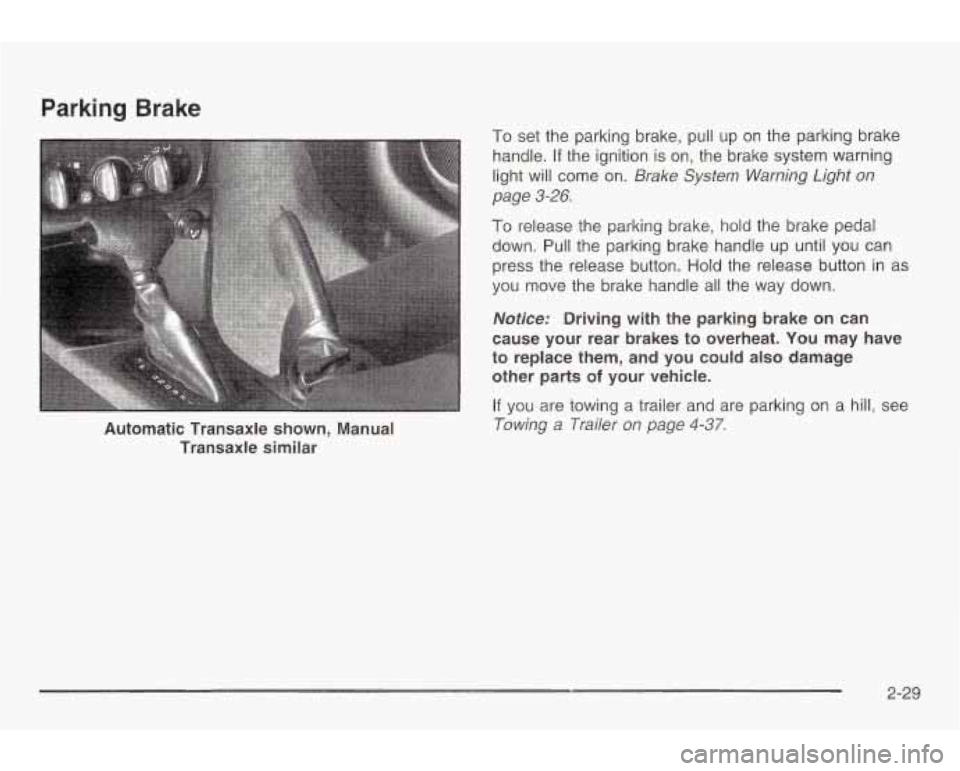
Parking Brake
Automatic Transaxle shown, Manual Transaxle similar
To set the parking brake, pull up on the parking brake
handle.
If the ignition is on, the brake system warning
light will come on.
Brake System Warning Light on
page
3-26.
To release the parking brake, hold the brake pedal
down. Pull the parking brake handle up until you can
press the release button. Hold the release button in as
you move the brake handle all the way down.
Nofice: Driving with the parking brake on can
cause your rear brakes to overheat. You may have
to replace them, and you could also damage
other parts
of your vehicle.
If you are towing a trailer and are parking on a hill, see
Towing a Trailer on page 4-37.
2-29
Page 99 of 354
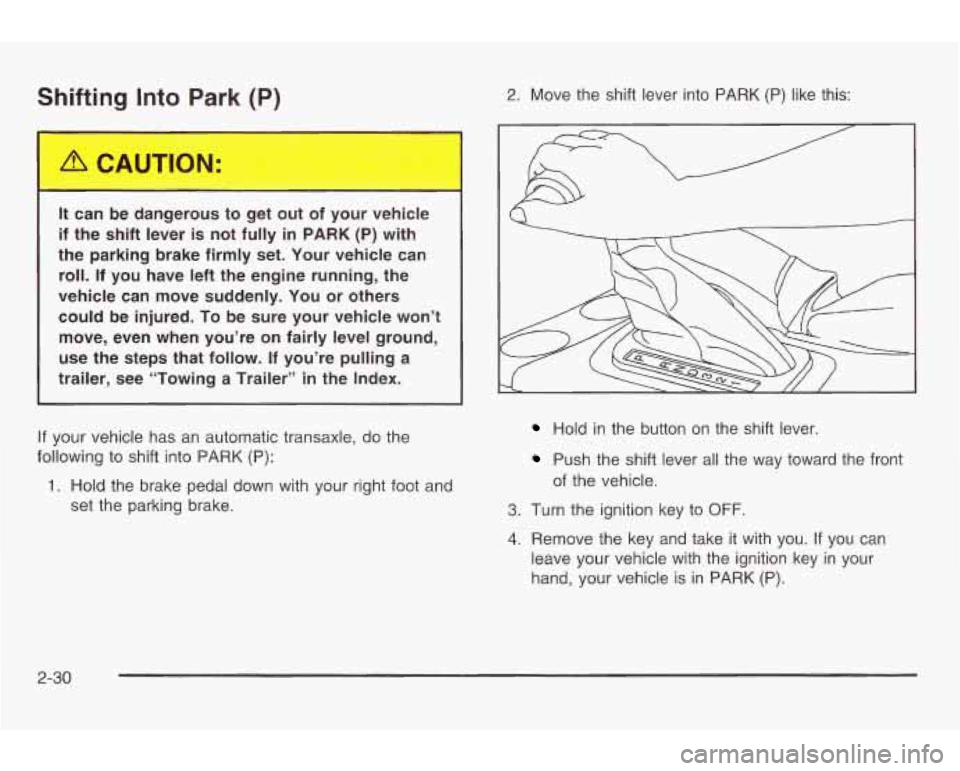
Shifting Into Park (P) 2. Move the shift lever into PARK (P) like this:
It can be dangerous to get out of your vehicle
if the shift lever
is not fully in PARK (P) with
the parking brake firmly set. Your vehicle can roll. If you have left the engine running, the
vehicle can move suddenly. You or others
could be injured. To be sure your vehicle won’t
move, even when you’re on fairly level ground,
use
the steps that follow. If you’re pulling a
trailer, see “Towing a Trailer” in the Index.
If your vehicle has an automatic transaxle, do the
following
to shift into PARK (P):
1. Hold the brake pedal down with your right foot and
set the parking brake.
Hold in the button on the shift lever.
Push the shift lever all the way toward the front
of the vehicle.
3. Turn the ignition key to OFF.
4. Remove the key and take it with you. If you can
leave your vehicle with the ignition key in your
hand, your vehicle is in PARK (P).
2-30
Page 100 of 354
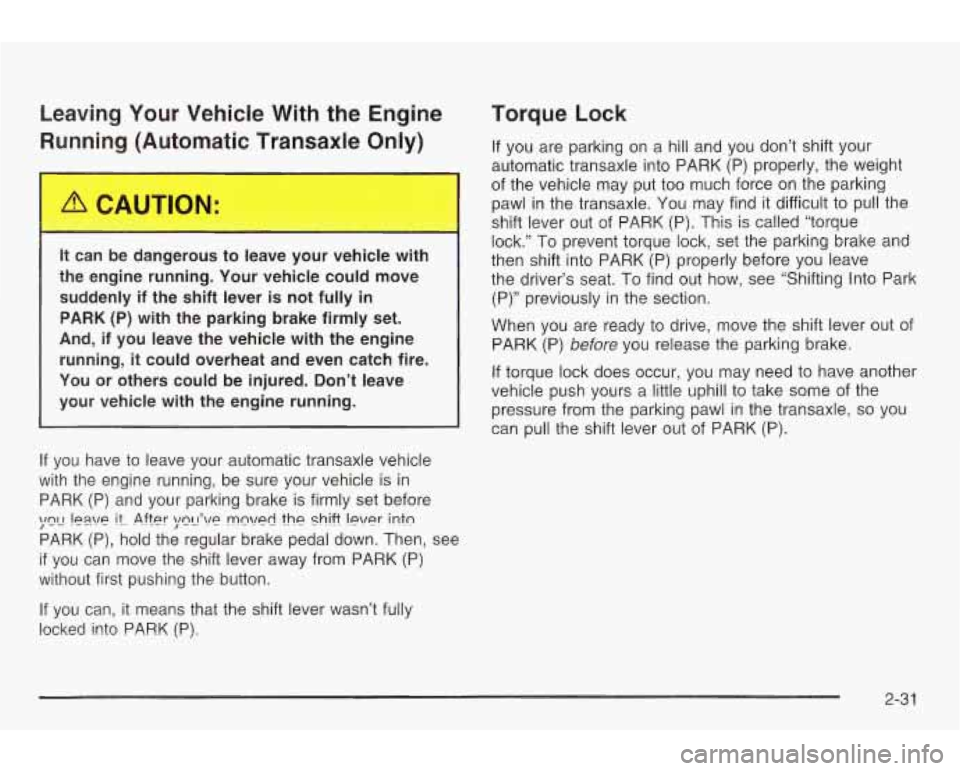
Leaving Your Vehicle With the Engine
Running (Automatic Transaxle Only)
It can be dangerous to leave your vehicle with
the engine running. Your vehicle could move
suddenly if the shift lever is not fully in
PARK (P) with the parking brake firmly set.
And, if you leave the vehicle with the engine
running, it could overheat and even catch fire.
You or others could be injured. Don’t leave
your vehicle with the engine running.
If you have to leave your automatic transaxle vehicle
with the engine running, be sure your vehicle
is in
PARK (P) and your parking brake is firmly set before
~QL! Ip31.1p it. .After y~iI’\.~p m~\/prj the shift Iwgr intn
PARK (P), hold the regular brake pedal down. Then, see
if you can move the shift lever away from PARK (P)
without first pushing the button.
If you can, it means that the shift lever wasn’t fully
!nrked into P.4p.K (PI.
Torque Lock
If you are parking on a hill and you don’t shift your
automatic transaxle into PARK
(P) properly, the weight
of the vehicle may put
too much force on the parking
pawl in the transaxle. You may find it difficult
to pull the
shift lever out of PARK
(P). This is called “torque
lock.”
To prevent torque lock, set the parking brake and
then shift into PARK (P) properly before you leave
the driver’s seat. To find out how, see “Shifting
Into Park
(P)” previously in the section.
When you are ready
to drive, move the shift lever out of
PARK
(P) before you release the parking brake.
If torque lock does occur, you may need to have another
vehicle push yours a little uphill
to take some of the
pressure from the parking pawl in the transaxle,
so you
can pull the shift lever out of PARK (P).
2-31